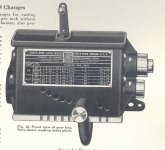Sorry to butt in, but;
This brings up a good question....is there an internet source for this type of info specifically regarding SB (10L) lathes? I know the book "how to run a lathe would probably explain it, but I've already spent too much money on this project. I'm wondering at this point exactly how my lathe works. I have run lathes before, but not any this old. I get the general idea, but the specifics are what I don't grasp. Such as; on the single tumbler gear box show above, how easy (or hard) should it be to change gears? On mine, the pin pulls and lever drops easily, but to move it left & right and to get it back up into your new selection can be tough...


 .
.

